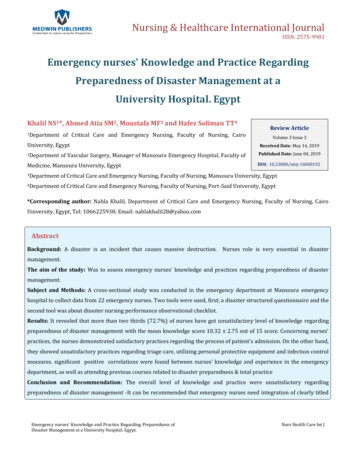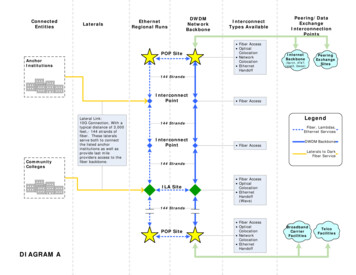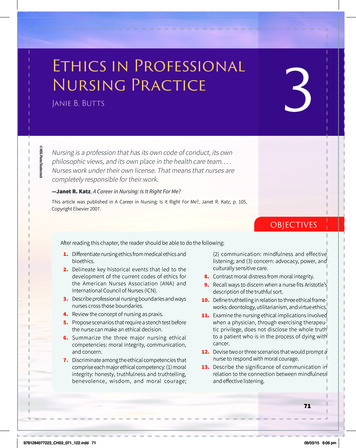
Transcription
Nursing & Healthcare International JournalISSN: 2575-9981Emergency nurses' Knowledge and Practice RegardingPreparedness of Disaster Management at aUniversity Hospital. EgyptKhalil NS1*, Ahmed Atia SM2, Moustafa MF3 and Hafez Soliman TT41DepartmentReview Articleof Critical Care and Emergency Nursing, Faculty of Nursing, CairoUniversity, Egypt2Departmentof Vascular Surgery, Manager of Mansoura Emergency Hospital, Faculty ofMedicine, Mansoura University, EgyptVolume 3 Issue 3Received Date: May 14, 2019Published Date: June 04, 2019DOI: 10.23880/nhij-160001923Departmentof Critical Care and Emergency Nursing, Faculty of Nursing, Mansoura University, Egypt4Departmentof Critical Care and Emergency Nursing, Faculty of Nursing, Port-Said University, Egypt*Corresponding author: Nahla Khalil, Department of Critical Care and Emergency Nursing, Faculty of Nursing, CairoUniversity, Egypt, Tel: 1066225938; Email: nahlakhalil28@yahoo.comAbstractBackground: A disaster is an incident that causes massive destruction. Nurses role is very essential in disastermanagement.The aim of the study: Was to assess emergency nurses' knowledge and practices regarding preparedness of disastermanagement.Subject and Methods: A cross-sectional study was conducted in the emergency department at Mansoura emergencyhospital to collect data from 22 emergency nurses. Two tools were used, first; a disaster structured questionnaire and thesecond tool was about disaster nursing performance observational checklist.Results: It revealed that more than two thirds (72.7%) of nurses have got unsatisfactory level of knowledge regardingpreparedness of disaster management with the mean knowledge score 10.32 2.75 out of 15 score. Concerning nurses’practices, the nurses demonstrated satisfactory practices regarding the process of patient's admission. On the other hand,they showed unsatisfactory practices regarding triage care, utilizing personal protective equipment and infection controlmeasures. significant positive correlations were found between nurses' knowledge and experience in the emergencydepartment, as well as attending previous courses related to disaster preparedness & total practiceConclusion and Recommendation: The overall level of knowledge and practice were unsatisfactory regardingpreparedness of disaster management -It can be recommended that emergency nurses need integration of clearly titledEmergency nurses' Knowledge and Practice Regarding Preparedness ofDisaster Management at a University Hospital. Egypt.Nurs Health Care Int J
2Nursing & Healthcare International Journaltheory and practice, teaching courses about disaster and emergency preparedness into nursing curricula are crucialneeded and provided in respect to their training preferences.Keywords: Knowledge; Practice Preparedness; Disaster ManagementIntroductionLarge scale disasters around the world demonstratethat no one and no country is immune from the threat ofnatural or other tragedies [1]. Disasters occur every daysomewhere in the world with dramatic impact onindividuals, families and communities [2]. The firstdecade of the twenty first century had considerably raisedan awareness of the potential danger to moderncivilization from disasters, both natural and manmade [3].Disasters can classify to natural and manmade,natural disasters arise from forces of nature and includeearthquakes volcanic eruptions, hurricanes, floods, fire,and tornadoes. In addition infectious disasters can beclassified as epidemic or pandemic [4]. Manmadedisasters are due to identifiable human causes and may befurther classified as complex emergencies (e.g. wars,terrorist attacks) and technological disasters (e.g.,industrial accidents, explosions from hazardous material)[5].Emergency preparedness is comprehensive skills,abilities, knowledge, and actions that are needed torespond and prepare for a threat, actual or suspected,chemical, radiological, nuclear, biological, or explosive innature [6]. During major disaster events, the demand fornursing staff is much greater than the demands for anyother healthcare professionals [7]. Nurses shouldanticipate an expanded role during disaster events toinclude caring for the sick and injured, infection control,contingency planning to prevent further damage, triage,mass immunizations, mass evacuations, and treatment formass casualties [8].Aim of studyThe aim of this study is to assess emergency nurses'knowledge and practice regarding preparedness ofdisaster management.Subjects and MethodsA descriptive research design was utilized in thecurrent study. The study was conducted in the emergencydepartment at Mansoura emergency hospital. Theemergency department consisted of 8 emergency rooms(2 medical rooms, 2 surgical rooms, 2 accident rooms and2 treatment rooms in addition to 1 medical recovery room,1 surgical recovery room, 1 poisoning treatment room, 1orthopedic room, 1 x-ray and 1 CT room, it receivespatients from emergency days of the hospital. Aconvenience sample was obtained from 22 emergencynurses with various ages, sexes and years of experienceand level of educations who worked during disaster in theemergency days (Sunday, Tuesday and Thursday).ToolsTwo tools were developed and utilized by theresearcher for data collection, after reviewing the relatedliteratures [9-12].Tool I: Disaster Knowledge Structured Questionnaire:It was consisted of two parts:Part 1: Nurses' Demographic Data:It included questions related to the emergency nurses'demographic data such as: name, age, sex, academicqualifications, years of experience in emergencydepartment and attending training program regardingdisasters preparedness.Part 2: Disaster Nurses' Knowledge Questionnaire:It composed of 15 questions in relation topreparedness of disaster management in the form ofmultiple choice questions (MCQ) such as: Definition ofdisaster (1 item), Types of disaster (2 items), Causes ofdisaster (3 items), Management of disaster (3 items) andRole of hospital and emergency nurse during disaster (6items). The Scoring system of the nurses' knowledgequestionnaire distributed as follows; each correct answerscored 1 mark and each incorrect answer scored zero.Total score for knowledge was 15 point. A higher scoreindicated a greater nurse’s knowledge. Knowledge scorewas categorized as follows: Scores less than 85% (lessthan 12.75 mark) was considered unsatisfactory and thescores equal or more than 85% (equal or more than 12.75marks) considered satisfactory [13,14].Tool II: Disaster Nurses' Performance ObservationalChecklist:It was developed by the researchers to assessemergency nurses’ practices regarding preparedness ofdisaster management in the emergency department; itKhalil NS, et al. Emergency nurses' Knowledge and Practice Regarding Preparedness of DisasterManagement at a University Hospital. Egypt. Nurs Health Care Int J 2019, 3(3): 000192.Copyright Khalil NS, et al.
3Nursing & Healthcare International Journalincluded 36 items covering the following points: Patientadmission (How to admit patients in disastermanagement?) (4 items) using a triage during the care ofpatients in disaster management (14 items) and usinguniversal precautions during giving care to patients indisaster management (18 items). The Scoring system ofthe nurses' practices were distributed follows as; eachstep done complete and correct was given 2 scores, eachstep done incomplete was given 1 score and not donesteps scored zero. The total scores of practice were 72marks. Practice score was categorized as follows: Scoresless than 85% (less than 61.2 marks) was consideredunsatisfactory and the scores equal or more than 85%(equal or more than 61.2 marks) considered satisfactory[13,14].Data Collection ProcedureAn explanation about the aim and the nature of thestudy was discussed with nurse's staff in the emergencyunit. Emergency nurses' knowledge about disasterpreparedness was assessed using interviewingquestionnaire in the non-emergency day (using tool I, partwith each emergency nurse. Questionnaire was doneindividually; complete instructions regarding answeringthe questionnaire sheet were given to the emergencynurses. The average time for completing thequestionnaire sheet ranged from 10–15 minutes.Assessment of emergency nurses' practice during disastermanagement was done for each one while worked withthe patients through observational checklist using (tool II).Legal and Ethical ConsiderationsThe research ethical committee permission to conductthe study was obtained from the hospital administrativeauthority after explaining the aim and the nature of thestudy , Faculty of Nursing , Mansoura University toaccomplish this study, verbal consent was obtained fromemergency nurses, the purpose of the study wasexplained to the emergency nurses, reassurance wasgiven to the emergency nurses about confidentiality oftheir responses and nurses were informed that they hadthe right to withdraw at any time from the study. All dataand information obtained were protected through codingto ensure confidentiality.Procedure of Data CollectionTwo phases: the preparatory and implementation phasePhase I: preparatory phase:This phase involved preparation of data collectiontools based on reviewing current, national andinternational studies. The tools were developed by theresearcher and tested for validity and reliability.Validity and ReliabilityTools were developed by the researcher afterreviewing the relevant literature and tested for its validityby jury of 5 expertises in the field of emergency and theirrecommended modifications had been done. Thereliability of the tools was tested by using the Cronbach'Alpha test in SPSS as the following: The Cronbach's Alphaformula was 0.67 for knowledge questionnaire and TheCronbach's Alpha formula was 0.90 for disaster nurses'performance observational checklist.Pilot StudyThe pilot study was conducted on 10 % of theemergency nurses who were selected randomly from thesame setting then excluded from the studying sample, onthe other hand 5 nurses were excluded from the studybecause they refuse to participate. The purposes of thepilot study were to ascertain the clarity and applicabilityof the tool to estimate the time needed to answer thequestionnaire and to identify any possible obstacles thatmay hinder data collection.Phase II: Implementation phase:The researcher visited the emergency hospital (ER) atthe morning shift from 8am-to-2pm on all emergencyhospital days (Sunday, Tuesday, Thursday) to check forany disaster and contact with some emergency headnurses and hospital members who work in ER to beinformed about any disaster that may occur on these days.The study disaster was fire accident due to the explosionof a gas stove which consisted of 22 emergent casesarrived to emergency unit in the morning shift onThursday 6/9/2018. The ages of the injured ranged from6 years to 75 years with varying degrees of burns. 10cases were discharged after their condition improved. Theother 12 cases were transferred to ICU where the acutecare was provided to them and the other 2 cases weretransferred to the center for burns and beauty due to theircritical condition and their increased severity.Data AnalysisThe raw data were, sorted, coded, and analyzed usingSPSS system files (SPSS package version 18). Analysis andinterpretation of data were conducted. The followingstatistical measures were used: Data were fed to thecomputer and analyzed using IBM SPSS software packageversion 20.0. (Armonk, NY: IBM Corp) descriptive dataKhalil NS, et al. Emergency nurses' Knowledge and Practice Regarding Preparedness of DisasterManagement at a University Hospital. Egypt. Nurs Health Care Int J 2019, 3(3): 000192.Copyright Khalil NS, et al.
4Nursing & Healthcare International Journalwere described using number and percent. Quantitativedata were described using range (minimum andmaximum), mean, and standard deviation. Significance ofthe obtained results was judged at 0.05 levels. T- Test wasused to compare between two studied groups in relationto knowledge score. Moreover, F-test (ANOVA) was usedto compare between more than two groups of nurses. Inaddition Pearson coefficient was utilized to correlatebetween two normally distributed quantitative variablessuch as knowledge, practice and selected demographicvariables.ResultsNurses Demographic DataNo.%26–3536 –45 46Mean SD.153468.213.618.2Age34.18 7.22GenderMaleFemaleMarital statusSingleMarriedCurrent positionNurse staffHead of nursingAcademic qualificationsDiploma in nursingTechnical health instituteBachelor of nursingYears of experienceLess than 5 years5-10years 10yearsMean SD.Previous training course in disasterNoYesIf answer yesDuration of course (n 9)Day3daysOne weakMore than one weakNumber of courses (n 9)One courseThree 522.727139.131.859.19.95 3.8513959.140.9116111.111.166.711.14544.455.6Table 1: Frequency distribution of the emergency nurses demographic data (n 22).Khalil NS, et al. Emergency nurses' Knowledge and Practice Regarding Preparedness of DisasterManagement at a University Hospital. Egypt. Nurs Health Care Int J 2019, 3(3): 000192.Copyright Khalil NS, et al.
5Nursing & Healthcare International JournalThe selected emergency nurses 22 were studied. Thestatistical analysis showed that more than two third(68.2%) of the studied emergency nurses were between25-35 years old, two third of them (63.6%) were female,below three forth of them (72.7%) were married,concerning with the academic qualifications below threeforth of the studied nurses were had diploma in nursingand their current positions was nurses staff, concerningwith years of experience, more than half had 10 years ofexperience and finally more than half (59.1%) notattending previous training course in disaster (Table 1).As can be seen from Figure 1 more than two third(72.7%) of nurses revealed un satisfactory level ofknowledge regarding preparedness of disastermanagement with the mean knowledge score 10.32 2.75out of 15 score.Figure 1: Percentage distribution of the nurses'knowledge level and mean knowledge regardingdisaster management (n 22).Disaster nurse’s knowledge questionnaireDisaster isTypes of disastersEruption, earthquakes, high temperature or cooler weather and heavyrain caused great destruction of property and humans, and isconsidered a kind of disaster:Technological disasters are the results of the failure of use oftechnology, such as:Criminal acts and stampedes, riots and war is kind of the disasterJoint disasters between nature and humans, such asThe phases of disaster managementDisaster preparednessEmergency plan for disaster preventionEmergency nurses need to increase their knowledge inEmergency nurse tasksEmergency nurse should use of personal protective equipment (handwashing, wear gloves, wear gown, wear protective head, wearprotective boots and a face mask)Every hospital has a plan to cope with disasters, have internalguidelinesWhen confirm the occurrence of disasterOne of the disaster management barriersIncorrect answerNo.%522.7418.2Correct 00100Table 2: Frequency distribution of the emergency nurses correct/in correct answers regarding knowledge questionsrelated to preparedness of disaster management (n 22).As can be seen from Table 2 showed that all thestudied emergency nurses (100%) gave correct answer inthe following items related to every hospital has a plan tocope with disasters, have internal guidelines, whenconfirm the occurrence of disaster, one of the disastermanagement barriers, moreover, more than three forth(81.8%) gave correct answer regarding types of disasters,on the other hand more than two third reported incorrectanswer pertinent to the time for emergency nurse to useof personal protective equipment (hand washing, weargloves, wear gown, wear protective head, wear protectiveboots and a face mask) finally less than quarter (18.2%)reported incorrect answer pertinent to types of disasters.Khalil NS, et al. Emergency nurses' Knowledge and Practice Regarding Preparedness of DisasterManagement at a University Hospital. Egypt. Nurs Health Care Int J 2019, 3(3): 000192.Copyright Khalil NS, et al.
6Nursing & Healthcare International JournalDisaster nursing performance observationalchecklistHow to receive disaster patientObtain informed consent from the patient or familybefore beginning careAssess situation.Ensure that emergent patients receive care immediately.Ensure that urgent patients receive care within 30 min to2 hrs.TriageTake vital signsTake complete history from the patient or from thepatient's familyDo head to toe assessment.Take diagnostic test.Take laboratory test.Follow the ABCD methods.Establish a patent airway.Provide adequate ventilation.Evaluate cardiac output.Determine neurological disability.Apply E-C-G.Apply arterial lines.Apply urinary catheter.Splinting of suspected fracturesCleaning of wounds.Dressing of wounds.Plan for the patient safe discharge.Plan for follow up care.Not doneDone incorrect/incompleteNo.%Done correct 100100Table 3: Frequency distribution of nurse's correct/incorrect/not done practice regarding preparedness of disastermanagement (n 22).As can be seen from Table 3 that all the studiedemergency nurses (100%) demonstrated correct practiceregarding admit patient in disaster, take vital signs, takecomplete history from the patient or from the patient'sfamily, do head to toe assessment, take diagnostic test,take laboratory test, plan for the patient safe discharge &plan for follow up care, on the other hand more than half(54.5%) of the studied emergency nurses demonstratedin complete practice regarding apply E-C-G, also most ofnurses (86.4) were not inserted urinary catheter and all ofthem(100%) were not splinting of suspected fractures .As can be seen from Table 4 that all the studiedemergency nurses (100%) demonstrated correct practiceregarding placing needles in sharp's containers, on theother hand more than three forth (77.3%) demonstratedin correct practice regarding hand hygiene measures afterremoving gloves more over less than quarter (27.3%)demonstrated in correct practice regarding changinggloves before going to another patient and changinggloves when torn or heavily contaminated and also all thestudied emergency nurses (100%) demonstrated notdone practice regarding wearing protective eye whendirect contact with the patient, wearing mask when directcontact with the patient, wearing gown or apron whendirect contact with the patient, wearing overhead,wearing over shoes, not recapping needles after using,using syringes with retractable needle, using syringeswith protective shield, using sables with protective shield,using intravenous annulation with retractable needle.Khalil NS, et al. Emergency nurses' Knowledge and Practice Regarding Preparedness of DisasterManagement at a University Hospital. Egypt. Nurs Health Care Int J 2019, 3(3): 000192.Copyright Khalil NS, et al.
7Nursing & Healthcare International JournalNot doneDisaster nursing performance observational checklistPersonal protective equipment and infection control measures:Hand hygiene measures before starting the working activity.Hand hygiene measures before going to another patient.Wearing gloves when direct contact with the patient.Hand hygiene measures before wearing gloves.Hand hygiene measures after removing gloves.Changing gloves before going to another patient.Changing gloves when torn or heavily contaminated.Wearing protective eye when direct contact with the patient.Wearing mask when direct contact with the patient.Wearing gown or upon when direct contact with the patient.Wearing overhead.Wearing over shoes.Not recapping needles after using.Placing needles in sharp's containers.Using syringes with retractable needle.Using syringes with protective shield.Using sables with protective shield.Using intravenous annulation with retractable one incorrect / Done correct 00002200000054.504.554.554.50000001000000Table 4: Frequency distribution of nurse's correct/incorrect/not done practice regarding preparedness of disastermanagement "continue" (n 22).Action stepReceive the patientTriagePersonal protective measuresOverall practice 85% unsatisfactoryNo.%001463.62210022100 85% satisfactoryNo.%22100836.40000Table 5: Frequency distribution of emergency nurse's practice level in disaster management (n 22).It is apparent from Table 5 that all nurses did notperform or apply personal protective practices while all ofthe nurses showed satisfactory level regarding admissionof the patient.Action stepReceiveTriagePersonal protectiveOverall practiceTotal scoreMean SD.8.0 0.029.23 1.888.27 3.0145.50 4.18Table 6: Mean and standard deviation of sub and overallpractices regarding performance in disaster management(n 22).It is apparent from Table 6 all nurses showed highmean scores regarding admission of the patient, on theother hand the table showed low mean practice scoresregarding applying personal protective measures whileworking with the patient.Practices scoreReceiving a disaster patient scoreTriage scorePersonal protective equipment andinfection control measures scoreTotal practice scoreKnowledge scorerp010.4010.0640.0180.9370.1930.391Table 7: Correlation between mean knowledge scoresand mean practices scores regarding preparedness ofdisaster management among the studied emergencynurses.Correlation between mean knowledge scores andmean practices scores regarding preparedness of disasterKhalil NS, et al. Emergency nurses' Knowledge and Practice Regarding Preparedness of DisasterManagement at a University Hospital. Egypt. Nurs Health Care Int J 2019, 3(3): 000192.Copyright Khalil NS, et al.
8Nursing & Healthcare International Journalmanagement among the studied emergency nurses showsthat there is positive correlation between knowledge andpractice scores regarding patient's admission only,Socio-demographic characteristicsmoreover no significant correlation were found betweenthe total knowledge and the total practicescores(R 0.1,P 0.3) (Table 7).Knowledge score of nurses(n 22)SignificanceNo.Mean SD26–3536–4546 153468.89 21.3373.33 11.5565.0 10.0FemaleMale14870.0 16.4966.67 22.25t 0.402 p 0.692MarriedSingle16672.08 15.4460.0 23.85t 1.409 p 0.174NurseHead nurse16665.83 17.7076.67 19.21t 1.251 p 0.225161564.58 17.348080.0 19.44F 1.637 p 0.221271393.33 9.4355.24 19.8972.31 12.72F 5.717* p 0.011*91380.74 13.9260.51 16.66t 2.986* p 0.007*11611008076.67 14.4586.674581.67 20.6480.0 8.16Age (years)F 0.164 p 0.850GenderMarital statusCurrent jobEducational levelDiploma in nursingTechnical health instituteBachelor of nursingDuration of experience in emergency departmentLess than 5 years5 – 10years 10yearsAttend training related to disaster preparednessYesNoIf answer yesWhat was duration of course (n 9)Day3daysOne weakMore than one weakNumber of courses (n 9)One courseThree coursesF 0.808 p 0.541t 0.167 p 0.872Table 8: Comparison of knowledge scores among the emergency nurses regarding preparedness of disaster managementby their demographic characteristics.Comparison of knowledge scores among theemergency nurses regarding preparedness of disastermanagement by their demographic characteristics showsthat no significant difference were found on any nursesregarding knowledge about preparedness of disastermanagement except duration of experience in emergencydepartment (F 5.7, P 0.011) and attending previouscourses related to disaster preparedness (t 2.986,P 0.007) (Table 8).Khalil NS, et al. Emergency nurses' Knowledge and Practice Regarding Preparedness of DisasterManagement at a University Hospital. Egypt. Nurs Health Care Int J 2019, 3(3): 000192.Copyright Khalil NS, et al.
9Nursing & Healthcare International JournalSocio-demographic characteristicsPractice score of nurses (n 22)No.Mean SDSignificanceAge (years)26–3536–4546 153456.58 5.5058.75 7.6056.56 2.77FemaleMale14855.89 5.8958.59 3.50t 1.176 p 0.253MarriedSingle16656.25 5.5758.54 4.14t 0.912 p 0.373NurseHead nurse16656.09 5.2458.96 5.03t 1.153 p 0.262161555.94 5.315560.25 4.37271361.88 0.8855.54 3.4556.83 6.0591357.78 6.6456.25 4.18116161.2543.7558.54 4.5763.754557.19 8.9858.25 5.20F 0.206 p 0.815GenderMarital statusCurrent jobEducational levelDiploma in nursingTechnical health instituteBachelor of nursingDuration of experience in emergency departmentLess than 5 years5 – 10years 10yearsAttend training related to disaster preparednessYesNoIf answer yesWhat was duration of course (n 9)Day3daysOne weakMore than one weakNumber of courses (n 9)One courseThree coursesF 1.417 p 0.267F 1.162 p 0.334t 0.665 p 0.514F 3.958 p 0.086t 0.224 p 0.829Table 9: Comparison of practice score among the emergency nurse's regarding preparedness of disaster management bythe demographic characteristicsComparison of practice score among the emergencynurse's regarding preparedness of disaster managementby the demographic characteristics shows that nosignificant statistical differences were found betweennurse's practice regarding preparedness of disastermanagement and their demographic characteristics(Table 9).DiscussionThe finding of the current study showed that morethan two third of the emergency nurses were agedbetween 25 to 35 years participated in this study, fromthe researcher point of view this finding is related tonewly nursing graduate were appointed to work in theemergency unit. This result is nearly congruent withIbrahim FAA [3], who revealed that the majority of thenurses were aged below 30 years old, and also this findingis agreed with Zarei V [15], who found that two third ofthe participants aged between25 to 44 years old.Regarding nurses' gender, the present study showedthat two third of the emergency nurses were females, thismay be due to large number of female nurses were oftenpresent in the morning shift, this finding agreed withNofal A, et al. [16], who found that most of theKhalil NS, et al. Emergency nurses' Knowledge and Practice Regarding Preparedness of DisasterManagement at a University Hospital. Egypt. Nurs Health Care Int J 2019, 3(3): 000192.Copyright Khalil NS, et al.
10Nursing & Healthcare International Journalparticipants were females, as well as in the same line withLakbala P [17], who revealed that more than two third ofthe participant were females, and also the current findingis in consistent with Zarei V [15], who clarified that twothird of the participants were men.management and attending of previous disasterpreparedness courses. This finding is supported byIbrahim FAA [3], who found that knowledge levelregarding disaster preparedness showed highlysignificant differences.Moreover the finding of this study clarified that belowthree forth of the studied emergency nurses were had adiploma in nursing and worked in emergency unit inposition of nurse staff, this result may be due to increasethe number of graduates of nursing diplomas annuallyand this result is supported by Lakbala P [17], whoreported that two third of the participant were had adiploma in nursing.Concerning years of experience, present study showedthat more than half of the studied emergency nurses hadmore than 10 years of experience in the emergency unitand this finding is in the same line with Nofal A, et al. [16],who revealed that more than half of the participants had aclinical experience of more than 5 years.Regarding nurses' practice our findings showed thattotal practice score regarding preparedness of disastermanagement among the studied emergency nursesconsider satisfactory regarding patient's admission andconsider unsatisfactory regarding triage of care, personalprotective equipment and infection control measures. Theunsatisfactory level of nurses' practice may be due to lakeof educational courses regarding preparedness of disastermanagement, the element of sudden and young age ofnurses. Our study finding is agreed with a similar studydone by Ibrahim FAA [3], who found that practices ofdisaster preparedness were below average level.Moreover our finding is in consistent with Sakhar V, et al.[20], who revealed that health care team members hadonly average practices regarding disaster preparedness.The findings of the current study also revealed thatmore than one third of the studied emergency nurses hadattending previous training courses in disaster. Thisresult is partially agreed with Lenox Hill Hospital [18],who found that only a quarter had training courses aboutdisaster, this may be due to hospitals have begun torealize the lack of disaster training courses and havestarted nursing courses regarding preparedness ofdisaster to increase nurses awareness regarding disastersdue to recurrent disasters in previous periods.The present study showed that all emergency nursesdone correct practice triage regarding take vital signs andthis result is in consistent with Rominski S, et al. [21], whofound that the majority of nurses were competent inmeasuring and recording vital signs once the patientarrives at ER. On the other hand our study finding is incontrast with Mansour H [22], findings who revealed thatlower level of triage knowledge and practice of studygroup of emergency nurses regarding assessment of vitalsigns before program implementation.Regarding nurses' knowledge regarding preparednessof disaster management our finding demonstrated thatthe majority of the stu
University Hospital. Egypt Khalil NS1*, Ahmed Atia SM2, Moustafa MF3 4and Hafez Soliman TT 1Department of Critical Care and Emergency Nursing, Faculty of Nursing, Cairo University, Egypt 2Department of Vascular Surgery, Manager of Mansoura Emergency Hospital, Faculty of Medicine, Mansoura University, Egypt DOI:











